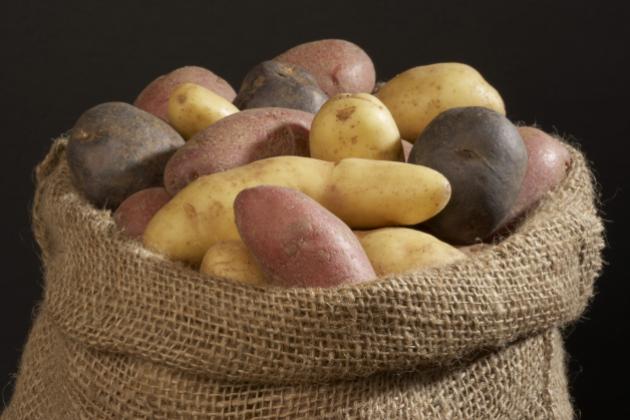In the new film “The Martian,” an astronaut stranded on Mars grows potatoes to subsist until help arrives. Nutritious and filling potatoes were a good choice: A 5.3-ounce baked potato has 110 calories, more potassium than a banana and almost half the recommended daily value of vitamin C—with zero fat.
The potato is getting even more remarkable thanks to modern genetic engineering. A variety that resists blight—potentially obviating the need for thousands of pounds of chemical sprays every year—is coming. But standing in the way has been dilatory and superfluous regulation by no fewer than three federal agencies.
Late blight, an infection by the water mold Phytophthora infestans, is what caused the infamous Irish potato famine in the 1840s. Wet weather patterns on the Emerald Isle gave rise to massive outbreaks of the fungal disease, which is spread by wind currents and rain. Potato crops rotted in epic proportions. Left without their staple crop, an estimated one million people starved to death. A million more left the country in search of food.
More than a century and a half later, late blight is still a major problem for farmers. In most places it can be controlled with fungicides, which are commonly sprayed as often as 15 times a season. This summer was particularly bad for late blight in Michigan, Idaho, Pennsylvania and Wisconsin, wiping out crops and sending farmers scurrying for the fungicides.
But a wild variety of potato from the Andes mountains displays natural resistance to certain strains of late blight. Geneticists at Simplot Plant Sciences introduced a gene from this variety into ordinary Russet Burbank potatoes to create the second generation of the company’s “Innate” potato. Simplot says in its petition for regulatory approval from the Agriculture Department that the new potato should provide American farmers relief from the most pervasive strains of late blight. That means it could reduce fungicide use by 495,000 pounds annually, according to Joe Guenthner, a 30-year potato-research veteran and professor emeritus at the University of Idaho.
As a bonus, Innate potatoes—both the new version and the first generation, which is currently on the market—are bruise-resistant. Simplot estimates that widespread adoption could reduce waste by producers, shippers and retailers by 240 million pounds annually. It could also make a dent in
the estimated three billion pounds of potatoes discarded each year by consumers. Innate potatoes also contain lower levels of asparagine, an amino acid found in all potatoes that can turn into a probable carcinogen when heated to high temperatures. If ever a potato deserved “out of this world” status, this is it.
After a 17-month review, the USDA in August finally signed off on the second-generation Innate potato, the one with blight resistance. The USDA review ensured that the potato is not a plant pest and will not adversely affect other plants or the environment. Simplot’s 199-page application contained two years of data from field trials around the country to demonstrate that a potato plant that contains only potato genes performs, well, like a potato.
But the blight-resistant potato still needs the blessing of the Environmental Protection Agency and the Food and Drug Administration. The FDA safety review—which is theoretically voluntary, although companies don’t dare go to market without its seal of approval—will ensure that there are no significant differences in nutrition or other health-related factors between the new genetically engineered variety and its conventional counterpart. That review has been pending since April 2014.
The EPA claims authority to review the potato under the aegis of the federal pesticide statute, because the potato contains a “plant-incorporated protectant.” This risible policy lacks any basis in either science or common sense; the pesticide legislation was intended to regulate toxic chemicals. Nonetheless, Simplot expects to submit its application to the EPA later this month.
Interestingly, none of these regulatory reviews, by the USDA, FDA or EPA, would have been required if the genetic modifications had been performed with less precise, less predictable older methods that move large numbers of genes—such as irradiating seeds to mutate them or moving genes from one species or genus to another by hybridization—instead of state-of-the-art molecular techniques. If you think this makes no sense, you’re in agreement with the scientific community.
The length of time required for these regulatory reviews is absurd. What makes me an expert on approval times? I led the FDA team that examined early bioengineered drugs. In 1982 we were able to review and approve genetically engineered human insulin, the very first drug made with recombinant DNA technology (or “gene splicing”), in five months.
Bringing a new biotech crop to market, from inception to product introduction, takes on average 13 years and more than $130 million, according to
a 2011 study for CropLife International. A more scientific approach to regulation could shorten that pipeline, putting important new products like the Innate potato into fields (and onto tables) much more quickly, reducing waste, cutting the use of chemical sprays and limiting consumption of a naturally occurring carcinogen.
Congress ought to act—but I’m not betting the farm on it.
Dr. Miller, a physician and molecular biologist, is a research fellow at Stanford University’s Hoover Institution. He was the founding director of the FDA’s Office of Biotechnology.


















